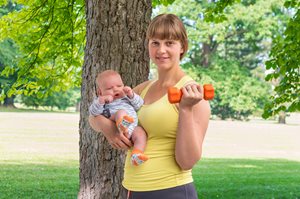Postnatal Caesarian Ab Separation

A postnatal mum had a caesarean section and came in just over 1 week after the birth to have the recovery shorts fitted. She was taught postnatal abdominal bracing exercises and could do these in sitting and standing and was advised to activate her brace also when moving, for example when getting up out of a chair or getting out of bed. Doing this helped to ease discomfort that she was feeling from the caesarean site at the time. She was also provided with some caesarean recovery information.
She came in for a check at 6 weeks and felt she was healing well. She had been doing the postnatal abdominal bracing exercises and wearing the recovery shorts regularly.
During her pregnancy she had been to a personal trainer, doing 2 PT days and 3 gym days, so she was planning to recommence exercise to include walking, stationary cycling, and gradually introduce weights again, as she had only used light arm weights during her pregnancy. She had done squats during pregnancy so felt comfortable to recommence them, and used the rower, so around 8 weeks she planned to recommence with the rower with light resistance levels to start with. Returning to boxing was something she would like to do but she thought at this point she would wait for between 3-6 months before considering.
At 6 weeks so she could commence home exercises using her swiss ball she was given:
-
Wall ball squats to ¾ lowering level to minimise the increase in load in her lower abdominal wall for the first 1-2 sessions.
-
Postnatal abdominal bracing with the ball behind her back in standing, adding in single arm lifts to build endurance at this initial low level
-
Postnatal abdominal bracing sitting on the ball – at this point she could do 4 reps of alternate arm raises while holding in her abdominal wall well.
-
In supine she could do 2-3 reps on each side of a single leg roll out with good technique, re-recruiting between each rep at this stage, aiming to progress to 3 reps in a row over time without re-recruiting, then building the number of reps.
-
4 point kneeling position was a good position for giving her feedback on her recruitment patterns, initially focusing on shortening of her lengthened abdominal wall without a breath hold.
The aim was to build these over 1-2 weeks and increase the level and load progressions when she returned to the gym with her trainer. At this point she was advised to avoid sit ups and planks due to her abdominal wall recovery level.
She planned to come back for a further postnatal check in 4-6 weeks time.
.jpg.aspx)
Several months later when 3 months postnatal, she returned having noticed in the past week that her upper abdominal wall felt unusual and sometimes had a noticeable bulge. She had started curl ups on the ball in the gym in the past week and was doing a modified plank for 40 second holds with a break between for 3 reps.
Lunges and weights felt comfortable.
On checking of her abdominal muscle separation, it was 3 fingers above in a resting position closing to 2 fingers as she lifted her head with slight bulging of the linea alba, which and was 1 finger width at and below her umbilicus (belly button level).
On testing of a modified plank at 20 seconds there was increased pressure felt through the upper abdominal wall and from 30-40 seconds tension increased further. She was advised at this point to cease this exercise and given alternative exercises to do when on holidays for the next month. This allowed her to have a break from the gym and to focus more on postnatal core rebuilding and control work.

When testing the curl up over the ball, as she felt the level of work in the upper abdominal wall occurring and relates this to when she felt the change in her abdominal wall occurring. She was advised to also cease this as an exercise and given alternatives including working in side-lying, hands and knees and kneeling to work on rebuilding recruitment patterns in the deeper abdominal wall layer, building endurance and maintaining recruitment patterns when adding movement.
After her holiday at 4 months postnatal she returned for a check. She had done her exercises most days and on checking her gap above the umbilicus had reduced to 1 ½ fingers width, it was flatter during a head lift and only a very small bulge could be seen at the umbilicus level. The gap at the umbilicus was 1 finger width and below was now ½ finger width. She was given further progressions for her postnatal core retraining building the load and progressing the reps for each new exercise.
.jpg.aspx)
At 5 1/2 months at a follow up check her gap was 1 ½ finger widths above reducing to 1 finger width when she activated her deep abdominal wall first before the head lift with no bulge visible. A 1 finger gap remained at her umbilicus level with a minimal gap felt below the umbilicus. She was given further progressions for her postnatal core retraining and was able to work with her personal trainer to include the modified abdominal/core training side of her program and continued to work after this on building her deep core control and overall fitness.
This story has been used with permission from the client.